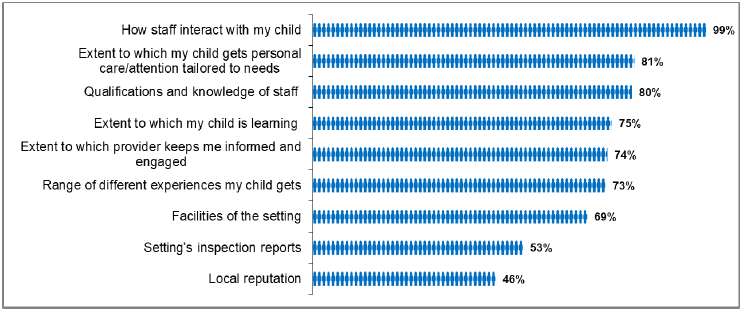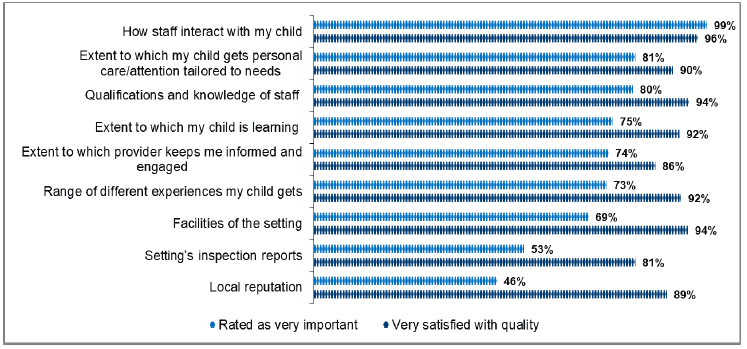Parents' views and use of early learning and childcare: report 2017
Information on parents’ and carers’ current use, future potential use, views and experiences of early learning and childcare.
This document is part of a collection
Quality of early learning and childcare
Ensuring available ELC is of high quality is also a primary objective of the planned expansion. This reflects the wider research literature which demonstrates that higher quality ELC can contribute to better social, emotional and cognitive development for children.
This section considers parent views on the factors that are most important to parents' judgement of the quality of ELC, and on the quality of their current provider against these factors.
Key aspects of early learning and childcare
Staff were rated as the most important factor for parents' judgement on the quality of ELC providers. This included how staff interact with their child (99% see this as "very important"), the extent to which their child gets personal care and attention (81%), and staff qualifications and knowledge (80%).
The extent to which their child is learning, how providers keep parents informed and engaged, and the range of different experiences that their child gets were also important factors for parents. In contrast, parents were less likely to rate the provider's reputation and inspection reports as "very important", despite reputation being the second most common motivation for parents' choice of their current provider (see Figure 7). This may reflect comments noted later from some qualitative participants, that parents can find it difficult to judge quality of ELC in advance of choosing a provider, and that reputation and word of mouth are important aspects of this decision.
Figure 27: Aspects rated as "very important" for parents judging quality of ELC

Qualitative feedback suggested that parents are varied in their views and experiences of judging the quality of ELC provision. All agreed that quality is a vital element in their choice of provider, but there was a mix of views on how well parents felt able to judge this. For example some parents, particularly those without prior experience of using ELC, found it difficult to judge the quality of providers prior to their child taking up a place.
These parents highlighted word of mouth from other parents as particularly important to their judging the relative quality of providers – including as a means of helping them to identify the key aspects of provision that make for a good quality service. Some of those who found it difficult to judge quality indicated that they had chosen to use a local authority nursery as they felt more comfortable that a minimum quality standard would be provided. This appeared to reflect a perception that there is greater variation in the quality of private ELC providers, than local authority providers.
Parent H has two children aged 2 and 3 years. Both are currently in private nursery. Parent H felt that available reports and information on ELC providers did not give a real sense of the quality of provision – particularly staff experience and manner, which they feel is a key factor. Canvasing opinion from friends and neighbours was important for their choice of provider – although they were concerned that word of mouth could be out of date due to high turnover of staff in some providers.
Other information used by parents to judge the quality of ELC included inspection reports and visits to providers. Parent visits were highlighted by most participants as a vital part of their assessing the quality of provision. This was seen as a means of judging staff experience/attitude and other factors listed at Figure 27 above, but also to get a sense of the "atmosphere" created by the provider. This included reference to less tangible aspects of provision such as the extent to which providers create a friendly and welcoming environment for children. Parents also emphasised the importance of their child's response to the provider during the visit, including examples where a child's positive reaction had influenced the choice of provider even where this was not the parent's first choice ( e.g. based on reputation or inspection reports).
"It was my first child, I didn't know anything about childcare or how to judge it."
"[Choosing] was really daunting the first time. We visited once by arrangement and once unannounced – a recommendation from a friend to get a feel for the atmosphere. But I remember being terrified turning up, I'd never been in a nursery before, I'd never done this before…But [the visit] and chatting to other parents was a big help."
As noted earlier, the accessibility of ELC also had an impact on how some parents consider the quality of provision. This included some who felt that they did not have the "luxury" of comparing the quality of alternative providers, as there was insufficient choice or flexibility in terms of the days/hours they required.
"Thankfully it has worked out well, but we didn't really have a choice [to compare the quality] – people were refused entry this year as they were over-full."
In terms of the specific aspects of ELC that inform quality judgements, parents were diverse in their priorities. This included a mix of views on the balance between their child's learning, social development and wider experiences. To some extent this appeared to be linked to the child's age; parents of younger children ( e.g. under 3) appeared more likely to focus on staff attitude, social interaction and stimulating experiences, while parents of older children (particularly 4-year olds) focused more on the quality of learning and preparation for school.
Parent J has a 4-year-old with ASN who is non-verbal. A single parent in a remote rural area, Parent J started using their private provider to enable a return to work when their child turned 1. Following a diagnosis of ASN at the age of 3, the quality of provision became even more important. The provider's willingness to work with Parent J to develop strategies to support their child's needs, and to provide a nurturing environment have been key factors for their child's experience, and Parent J's sense of the quality of provision.
However, on the topic of judging the quality of ELC, the following common points were raised:
- Where parents have knowledge of providers based on previous experience, this is particularly important for their quality judgements.
- Staff qualifications and experience are important, with some parents noting concern regarding the potential for variation across providers, and a lack of clarity on how staff qualifications may compare between local authority and private providers.
- One-to-one contact with staff, and the amount of time that staff can dedicate to their child, appeared to be a particular priority for parents of children with ASN. Some preferred a childminder to a nursery as a means of providing more individual support.
- Feedback from their child is also important for parents' quality judgements, including parents listening to their child's explicit views, and looking for evidence of their child's development. Parents expressed a mix of views on the relative benefits of local authority and private providers; some felt that local authority providers offer more structured learning in preparation for school, while others felt that private providers can offer more personalised learning.
- Flexibility of the provider to accommodate parents' needs in terms of days and hours was another indicator of quality for parents.
Rating the quality of ELC provision
Parents were asked to rate the quality of their main ELC provider against the same set of factors (see Figure 28 below).
A large majority of parents were satisfied with their current provider; at least 80% of parents were satisfied with each of the aspects listed in Figure 28. Satisfaction was strongest for how staff interact with their child (96% satisfied), staff qualifications and knowledge (94%) and facilities at the setting (94%). This indicates that parent satisfaction is strong for the aspects of their provision that parents see as most important.
Figure 28: Rating the quality of main ELC provider

Views and experiences across parent groups
The research identified some significant variation across parent groups in views and preferences on the factors that are most important to parents' judgement of the quality of ELC, and on the quality of their current provider against these.
This variation primarily related to income, deprivation, whether parents pay for ELC and parents of children with ASN. For example lower income households and those in the most deprived areas were more likely to rate a range of factors as very important to the quality of ELC, and more satisfied across all aspects of their current provider. In contrast, those who pay for ELC and parents of children with ASN were less likely to rate a range of factors as very important, and the latter group were also less satisfied with several aspects of their current provider.
Below we summarise the main variations across parent groups, highlighting where parents were significantly more or less likely than those in other parent groups to give a specific response.
| Low incomes/Most deprived areas |
More likely to rate staff qualifications/ knowledge, facilities, whether their child is learning, the provider keeping parents informed and inspection reports as very important. More likely than others to be very satisfied across all aspects of their main provider. |
|---|---|
| Rural areas |
No significant variation. |
| Single earner households |
No significant variation. |
| Parents of children with ASN |
Less likely than others to rate staff qualifications/ knowledge, facilities and inspection reports as very important. Less likely to be very satisfied with staff qualifications/ knowledge, how staff interact with their child, facilities and their child's learning. |
| Currently pay for ELC |
Less likely to be very satisfied with staff qualifications/ knowledge, how staff interact with their child, their child getting personal care and attention, their child's learning, and the provider keeping parents informed. |
| Do not currently use funded ELC |
No significant variation. |
| Other significant differences |
Parent age: Under 35s are more likely to rate facilities, whether their child is learning, the provider keeping parents informed and inspection reports as very important. They are also more likely to be very satisfied with their child's learning. Parent gender: Females are more likely to rate staff qualifications/ knowledge, their child getting personal care and attention, the provider keeping parents informed and inspection reports as very important. |
Contact
There is a problem
Thanks for your feedback